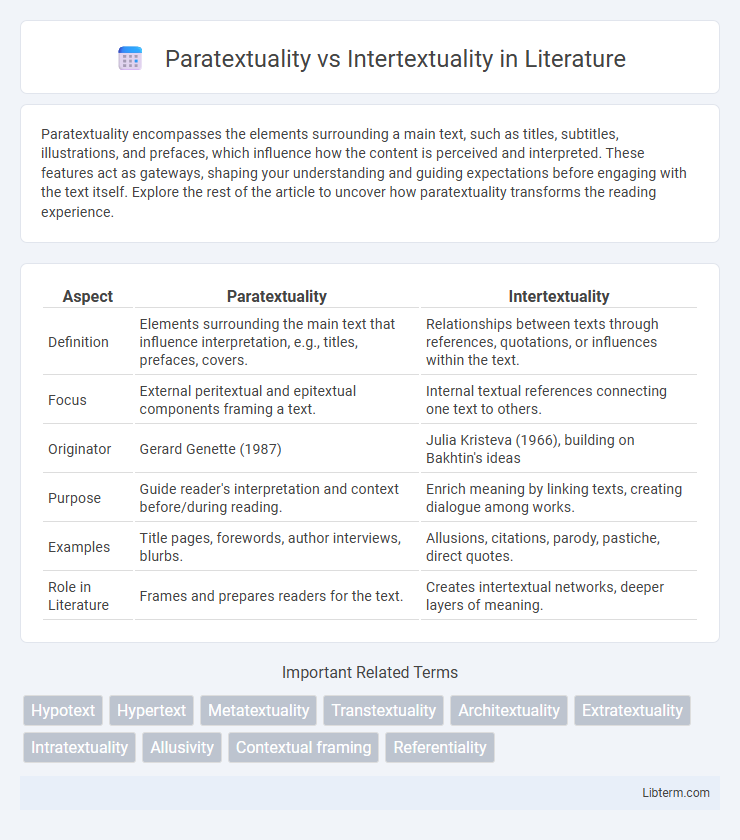Paratextuality encompasses the elements surrounding a main text, such as titles, subtitles, illustrations, and prefaces, which influence how the content is perceived and interpreted. These features act as gateways, shaping your understanding and guiding expectations before engaging with the text itself. Explore the rest of the article to uncover how paratextuality transforms the reading experience.
Table of Comparison
| Aspect | Paratextuality | Intertextuality |
|---|---|---|
| Definition | Elements surrounding the main text that influence interpretation, e.g., titles, prefaces, covers. | Relationships between texts through references, quotations, or influences within the text. |
| Focus | External peritextual and epitextual components framing a text. | Internal textual references connecting one text to others. |
| Originator | Gerard Genette (1987) | Julia Kristeva (1966), building on Bakhtin's ideas |
| Purpose | Guide reader's interpretation and context before/during reading. | Enrich meaning by linking texts, creating dialogue among works. |
| Examples | Title pages, forewords, author interviews, blurbs. | Allusions, citations, parody, pastiche, direct quotes. |
| Role in Literature | Frames and prepares readers for the text. | Creates intertextual networks, deeper layers of meaning. |
Understanding Paratextuality: Definition and Scope
Paratextuality refers to the elements surrounding a main text that influence its interpretation and reception, including titles, prefaces, book covers, and author annotations. These paratexts function as thresholds that guide readers' understanding and frame the text's meaning before direct engagement with the content. Unlike intertextuality, which deals with direct relationships between texts through references and quotations, paratextuality emphasizes the contextual materials that mediate the reader's experience and shape expectations.
Exploring Intertextuality: Meaning and Importance
Intertextuality refers to the shaping of a text's meaning by another text, emphasizing how literary works connect through references, quotations, or allusions, creating a network of cultural significance. It plays a crucial role in reader interpretation, allowing deeper understanding through recognizing these textual relationships and the socio-historical context embedded within. Understanding intertextuality enriches analysis by revealing how texts engage in dialogue, influence one another, and contribute to evolving literary traditions.
Key Differences Between Paratextuality and Intertextuality
Paratextuality involves the peripheral elements surrounding a main text, such as titles, prefaces, and illustrations, which guide interpretation and frame meaning, whereas intertextuality refers to the direct or indirect references and relationships between different texts that influence understanding through citation, allusion, or adaptation. Paratexts act as thresholds or boundaries shaping the reception of a primary work, while intertextual connections create a network of textual relationships enriching the reading experience through embedded contexts. The key difference lies in paratextuality's role as an external framing device, contrasted with intertextuality's function as an intrinsic textual dialogue linking multiple narratives.
Types of Paratexts: Examples in Literature and Media
Paratextuality includes elements like titles, prefaces, footnotes, and cover designs, which frame a primary text and influence its interpretation. Examples include the foreword of a novel, the director's commentary in a film DVD, and promotional blurbs on book covers. These paratexts function as gateways, guiding readers' or viewers' reception while remaining distinct from the text itself, unlike intertextuality, which directly references other texts within the main content.
Manifestations of Intertextuality in Texts
Manifestations of intertextuality in texts include direct quotations, allusions, and stylistic mimicry that create a network of references linking one text to another. Paratextual elements such as titles, forewords, and footnotes operate on the periphery, guiding interpretation and framing the main text rather than embedding intertextual connections within the narrative itself. Intertextuality enriches the reading experience by revealing dialogic relationships, thematic echoes, and cultural conversations across diverse textual works.
Functions of Paratextual Elements in Narrative Construction
Paratextual elements such as titles, prefaces, and illustrations serve as crucial guides that frame the reader's interpretation and expectation of a narrative, shaping its reception before the main text is engaged. These elements function to establish context, signal genre, and influence how the story is perceived, effectively bridging external world references and the internal narrative structure. In narrative construction, paratexts operate as threshold devices that condition meaning and reader engagement, differentiating their role from intertextuality, which involves direct textual relationships and influences between distinct works.
How Intertextual References Shape Reader Interpretation
Intertextual references directly influence reader interpretation by creating meaningful connections between texts, enriching the reading experience through recognition of allusions, quotations, or stylistic parallels. These references encourage readers to invoke prior knowledge and context, shaping understanding and emotional response uniquely for each individual. Unlike paratextual elements that frame a text's reception externally, intertextuality actively integrates multiple textual dimensions within the narrative itself, deepening thematic complexity and interpretive possibilities.
Paratextuality and Intertextuality in Digital Contexts
Paratextuality in digital contexts encompasses elements such as hyperlinks, metadata, and digital interfaces that frame and influence the interpretation of primary content, extending Gerard Genette's theory beyond traditional print. Intertextuality in digital media involves the dynamic interactions between various texts through social media posts, memes, and digital storytelling, creating layered meanings and cultural dialogues. Understanding the interplay of paratextual and intertextual elements is crucial for analyzing how digital platforms shape user engagement and meaning-making processes.
The Impact of Paratext and Intertext on Literary Analysis
Paratextuality shapes literary analysis by framing a text through elements like titles, prefaces, and cover art that influence interpretation before reading begins. Intertextuality deepens understanding by revealing how texts reference, echo, or transform other works, creating layers of meaning through literary connections. Together, paratext and intertext expand critical perspectives, highlighting how external cues and textual relationships inform thematic and contextual insights.
Comparing Effects: Paratextuality vs Intertextuality in Modern Works
Paratextuality shapes readers' expectations and frames interpretation by surrounding a text with titles, prefaces, and covers that guide understanding before engagement. Intertextuality, however, enriches meaning within the text itself through direct or indirect references to other works, creating layers of significance that deepen thematic complexity. Modern works leverage paratextual cues to influence reception contextually, while intertextual elements foster multidimensional dialogues between texts, amplifying interpretive possibilities and cultural resonance.
Paratextuality Infographic

 libterm.com
libterm.com